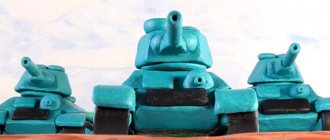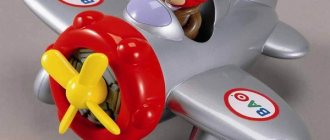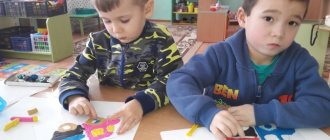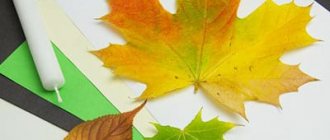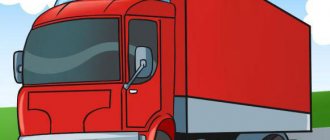Middle group. Junior preschool age. Children 4 - 5 years old
Summary of a modeling lesson in the middle group “Bird-whistle” Private preschool institution of preschool education “MIRACLE Andryushka” Modeling : “Bird-whistle, souvenir for home”
.
Prepared by teacher Lobazova S.A. Ramenskoye 2022 Age group: middle group Topic: “Bird - whistle, souvenir for the home
. Leading educational…
Summary of OD on modeling using natural materials with children 4–5 years old “Funny Hedgehogs”
Teacher of the highest qualification category Kurnina Lyubov Vladimirovna MBDOU kindergarten No. 54 “Teremok”
Kovrov, Vladimir region.
Dear colleagues, I invite you to get acquainted with the notes on OD on modeling using natural materials with children 4 - 5 years old “Funny Hedgehogs”
...
Modeling. All materials on sculpting - Notes on sculpting "Bird" for younger preschool age
Publication “Note of GCD on sculpting “Bird” for junior preschool…”
Goal: learn to sculpt a bird, develop creative abilities through sculpting. Tasks: - continue to teach children different techniques and methods of sculpting (kneading, rolling out a sausage - a roller between the palms, flattening parts, pinching plasticine to create an image...
Summary of an open lesson on modeling for teachers “Umbrellas for the Katya doll” in the middle group Summary of the lesson “Umbrellas for the Katya doll” Integration of educational areas: “Artistic and aesthetic development”, “Cognitive development”, “Speech development”. Types of activities: gaming, productive, communicative, motor. Goal: creating a colored umbrella figure in...
Modeling on a CD using the plasticineography technique for children 4–5 years old “Forest Beauty”
Teacher of the highest qualification category Kurnina Lyubov Vladimirovna MBDOU kindergarten No. 54 “Teremok” Kovrov, Vladimir region. Dear colleagues, I present to your attention a photo report on the sculpture “Forest Beauty”, made by children aged 4–5 years using the technique...
Summary of a modeling lesson “Treats for a doll” by Katya in the younger group from 3 to 4 years old Program content. Educational area “Artistic and Aesthetic Development”: continue to teach how to connect the ends of a stick rolled out of plasticine, strengthen children’s ability to roll out plasticine with straight movements between their palms, develop creative imagination. Integration…
Methods of teaching modeling in different age groups
Literature:
- Komarova T.S. and others. Methods of teaching visual activity and design. - M., 1991. - 256 p.
- Kosminskaya V.B. and others. Theory and methodology of visual activity in kindergarten. - M., 1985. - 255 p.
- Lykova I.A. We sculpt, we fantasize, we play. - M., 2000. - 112 p.
- Khalezova N.B. and others. Modeling in kindergarten. - M., 1986. - 144 p.
- Curriculum of preschool education /Ministry of Education of the Republic of Belarus - Minsk: Research Institute; Aversev, 2013.—416 p.
- Komarova T.S. Visual arts classes in kindergarten. - M., 1991. - 176 p.
- Svyatelik Z.I. We teach children to sculpt. Album. - K., 1989.
- G.G. Grigorieva. Development of preschool children in visual arts: A textbook for students. higher ped. textbook establishments. – M., 1999.
- Lykova I.A. Let's go and hum: plot modeling / I.A. Lykova. - M.: Karapuz, 2005. - [12] p. : silt
- With.
- Zhuk V.I. Modern Belarusian ceramics: development trends. -Mn., 1984.
- Sahuta Y.M. Belarusian folk dekaratyna-practical art. -Mn., 2001.-110 p.
- Sahuta Y.M. Hanchards: ... . Magazine "Praleska" No. 3, 2012
- Silivon V.A. Taught creativity to schoolchildren. - Mn., 1989. - 111 p.
- Khalezova N.B. Decorative modeling in kindergarten: a manual for teachers / N.B. Khalezova. – M.: Creative Center Sfera, 2005. – 110 p. : ill.
Methods
of teaching modeling in the first junior group
Materials and equipment for modeling
Usually in kindergarten they use clay and plasticine. Auxiliary materials for modeling include frames. To teach children how to sculpt, you can use ordinary sticks of different lengths and thicknesses as frames. With the help of a frame, the figures become more stable and dynamic. During the sculpting process you need to be able to use stacks. They can be wooden, which is easy to make yourself, or metal. The simplest form of stacka is a stick, pointed on one side and rounded on the other, but it can also be in the form of a loop, a stick with a wire loop.
A stack is used to process parts in cases where it is difficult to do by hand; with its help, excess clay is removed from the mold and cuts are made. To successfully teach children to model, it is good to have small boards that are placed on the table. Their size is determined by the size of the sculpt. If the figure is 15 X 10 cm in size, then the board can be 35 X 22 cm in size. If the figure is larger, then the board should be larger. The most convenient board shape is a circle, but it can also be square.
Modeling classes begin in a group of children in their third year of life. But first of all, it is necessary to introduce children to the material (clay or plasticine). It is most advisable to introduce children to the material in the process of performing an elementary action, with the help of which children can immediately obtain a visible result. For younger preschool age, it is typical to create three-dimensional shapes - a cylinder, a ball, a disk, therefore, training in formative movements should be carried out through modeling the simplest objects: a cylindrical shape - a stick, a sausage; round - ball, apple, pancake, flatbread, etc. After children have mastered the shaping movement of creating a cylindrical shape, children should be taught how to transform a cylinder - make a ring out of a stick. Children must look at the finished ring, and then the teacher consistently shows how to sculpt it. In the future, teach them to depict a more complex object - a cone or a simple toy pyramid. However, this object can be constructed constructively, from shapes known to children - rings of different diameters. In early preschool age, this technique is most appropriate, since modeling from a whole piece requires children to have a more complex form of understanding the image as a whole, which is still difficult for children in the third year. Before teaching children to depict an object, they must be taught to examine it, examine it, and be able to identify its main properties. Teaching images should be done through showing a real object or toy - in this case, a pyramid is considered. When considering a subject, the teacher should set the following goals:
- make the process of perceiving an object intentional (the teacher tells the children: “You and I will now look at the pyramid, and then we will sculpt it”);
- to arouse in children orienting activity, attention, and interest in the subject being examined;
- teach to identify the main parts of the subject;
- establish a connection between what is perceived and an existing skill.
These tasks are solved by examining all the objects that we lead children to depict.
The examination of an object should be carried out based on a fundamentally important sequence, namely: perception of a holistic image of an object, isolation of the main parts of this object, repeated holistic perception.
The next item that it is advisable to give for the image is a mushroom. Children need to master a new form-building movement - flattening (creating a disk). Mastering this movement should be done while modeling a simple object - a pancake. An adult shows how to tear off a piece of plasticine and flatten it with your fingers. This movement is quite accessible to children, since previous classes contributed to the development of more subtle movements of the fingers. Then the children sculpt a mushroom, which consists of two parts: a disk - the cap and a cylinder - the leg. These forms are already known to children.
After sculpting a mushroom, you can offer children 1-2 lessons on a free topic and move on to depicting a new object - a tumbler, which requires learning a new action with clay - rolling in a circular motion, which must be taught to children when sculpting a ball. This is the most difficult type of movement. Many children, having started it, switch to the usual rolling of clay between their palms in the same way as they did when making a stick.
Therefore, it is first advisable to invite the children to roll the finished ball. It is advisable for the teacher to perform this action together with the baby’s hands. Children once again sensually perceive the form, practice circular movements, which will then be easier for them to reproduce.
For modeling, you can use plasticine and clay, provided that they are properly prepared. Plasticine and clay should be given to children in the form of a sausage 5-6 cm long. Gradually, the teacher involves the children in preparing the lesson (they can put up chairs). Clay or plasticine is given to children after the task is explained. At the end of the lesson, the sculpted figures are put away on a board divided into cells. After the lesson, the teacher, together with the children, examines what they have done, gives a positive assessment of the work, compares it with the object depicted, and once again clarifies its main parts.
During the lesson, the teacher teaches children to sculpt while sitting at the table, not to scatter the material, and to clean it up after class.
2.3.2. Modeling in the second junior group.
In the second younger group, tasks of a visual and technical nature are associated with further teaching children to distinguish and sculpt a ball, cylinder, disk, orient in size, and compose simple figures from them.
The teacher gives the main place to information-receptive
and
reproductive methods
.
Together with the children, he examines balls, balls, fruits, pencils and other familiar objects. It is important that they hold the objects in their hands and feel the volume and size . For this purpose, small groups of 5-6 children are formed.
You can suggest
rolling the object between your palms
: if it is spherical, use circular movements; if it is cylindrical, use longitudinal movements.
Objects consisting of several parts are also examined in a similar way.
, for example, a tumbler doll. In this case, the teacher directs the children’s attention first to the shape of the main parts - the torso, head, and then to the smaller ones that complement the image - the arms.
Such active acquaintance with the form of an object not only leads to an understanding of the form
, but
also allows us to understand the structure
.
At the same time, the proportional relationships
between the parts are clarified: the body is the largest in size, the head is smaller than the body, and the arms are very small.
In addition , the number of parts is also analyzed
: one body, one head, two arms.
Almost all of these tasks were set in the first junior group; in the second junior group
acquaintance with the basic geometric bodies
also includes an initial generalization
: having mastered the shape of a ball or cylinder, see them later in other objects (a ball in an apple, orange, berries; a cylinder in a column, in a blank for lamb, etc.).
During the first lessons
in modeling, it is advisable for the teacher to show
the depiction techniques and explain them.
The kids sit facing the teacher. The teacher takes a lump of clay and comments on his actions (“I take a piece of clay, put it on my palm and roll it out like this: back and forth, back and forth. This is what the column turned out to be!”). All actions when demonstrating methods must be clear and understandable. To better consolidate this or that method of depiction, the teacher suggests making the necessary movements in the air before sculpting. Demonstration and explanation of image methods take no more than 3-4 minutes during the lesson.
Education of children in the second younger group (also children from 2 to 3 years old) should provide for the development of children's independence
.
Therefore, in cases where the techniques are familiar
, they
are not shown.
Result from the lesson
is achieved only if the teacher is able
to interest
the children in the upcoming modeling.
To do this, he plays with the theme of the lesson
, noting that the children will make gingerbread cookies for the dolls, or invites the sculpted tumbler doll to give a small flag in his hand, or put the chickens on a green sheet of paper representing a meadow, or place them near the mother hen, which the teacher has sculpted in advance. .
With the help of a game situation,
children
better understand the image
they create, which is very important, since
the main goal of the lesson
an expressive image
in modeling , using different means.
Doll with a flag
Hen with chicks
Analysis of children's work at the end of the lesson
a very important moment in the learning process.
But, as in the first younger group, the teacher analyzes
mainly
not the quality of individual images
,
but the overall result
(some children can be pointed out to shortcomings).
All teaching techniques used by the teacher are aimed at developing mental activity and independence using a variety of modeling methods.
DZ:
Make a lesson summary.
2.3.4. Modeling in the middle group
To successfully complete and consolidate the program throughout the year, the teacher selects appropriate teaching techniques
.
They use techniques that activate children’s attention
during modeling, as well as
techniques that expand their understanding
of the environment.
In a group and during walks, organizes examination of objects and observation of phenomena of surrounding life
, which he offers to the guys for the image.
The teacher directs the children’s attention only to the basic form, to elementary proportions
and
structure
and
only for those actions
that they
can understand
and then
depict.
For example, when examining birds, the teacher pays attention to the oval body, the round head, the small beak in comparison with the head, the flat tail, where the head is, where the tail is.
In order for children to remember the structure of an object, an examination is carried out
.
The teacher’s visual explanations (where is the body, where is the head, etc.) are repeated by the children. They should have an idea of the subject as a whole
: the form, its parts, proportional relationships. Then, while completing the task, the children will consciously solve the task.
At the first stages of learning, in order to understand the method of modeling, the teacher, visually analyzing parts of the object, resorts to comparison with those objects that the children know well.
For example, when children are making a doll, the teacher notes that its arms are like columns, and its body resembles a fat carrot.
The skills of 4-year-old children are still limited; they cannot do many things. At first, the oval shape is not always obtained; the parts are not connected by smearing. That is why the teacher explains and shows the method of sculpting, full or partial
.
Basically, children are shown unfamiliar modeling methods or those
that
have not been sufficiently mastered
.
In the middle group, the teacher teaches children to use some expressive means
: depict not only the basic shape of the object, but also characteristic details.
Examining objects, he directs the children's attention to such features
as a recess (apple), an elongated stalk (zucchini), etc. At the very beginning of teaching expressive means,
in order to increase interest in the result of modeling
, the teacher
prepares cuttings
(for carrots)
, leaves
(for apple). Gradually, during the learning process, the children themselves will begin to sculpt cuttings from clay, and then leaves.
Helps create a brighter image
, in addition to observing living objects, and
the method of “examining toys made by the teacher
(small sculptures, figurines). Two homogeneous figures are selected, but from different angles, for example, birds are pecking at food, rabbits are gnawing on carrots: one of the birds sits calmly, the other is pecking at food; one rabbit has its paws tucked under itself, next to it is a carrot, the other sits on its hind legs, holding a carrot with its front legs.
Modeling birds in different positions
Another, no less effective teaching method
-
playing on the theme and result of the work
. So, children place all the sculpted birds on one stand, calling it a feeder. The teacher sculpts the feeder in advance so that the children have the opportunity to see his work (you can use a board or thick cardboard for this purpose). The theme “Cake Modeling” is associated with the preparation of treats for dolls: at the beginning of the lesson, children sculpt treats for dolls, at the end they serve a table with sculpted products, around which the dolls are seated.
Correct proportions
children will learn to convey by mastering
the technique of comparison
. For example, when depicting a doll and its hands, the teacher takes a pre-fashioned column, divides it in half and, applying the resulting parts, demonstrates the same length. Children use the ability to compare parts and details of an image when sculpting different objects, for example, baskets from rings: they sculpt a disk bottom and 4 columns of the same length. Three make up a basket, and the fourth is used for a handle.
To arouse interest in children, a positive attitude towards the lesson, vivid figurative representations, the teacher reads short fairy tales, poems and riddles
, the content of which will help reveal the upcoming topic (for example, “Tail with a hook, nose with a snout. Who is it?”).
More expressive image
can be created
using a stack stick
.
The teacher shows how they cut clay into pieces
,
remove excess clay
, and
apply
small details
and
patterns
to some objects So, to depict the eyes of a rabbit, the figurine is placed on a stand, held with the left hand, and the eyes are outlined with the right hand using a stick.
Activities by design require special attention
, which are prepared by all previous work
.
At the beginning of the lesson , the teacher
leads the children to choose a topic
.
To do this, he asks them to remember what they saw on the walk, who they read about, etc. After determining the topic
and
starting work
the teacher
directs
the children’s attention to the expressiveness
with questions and advice .
“What is your bunny doing? - asks the teacher. “Make it clear to everyone that the bunny is sitting.” This is how the teacher activates mental activity
and teaches children
to work on the image.
Expanding children's understanding of the shape, proportions of an object, and methods of sculpting
, the teacher,
analyzing the results of the work,
conducts
a short conversation
so that the children think about the final result. The teacher complements the children’s answers, paying attention to the shape, proportions and structure, and the strength of the connection of the parts.
2.3.5.
Modeling in the senior group
In the senior group, the teacher uses methods and techniques that are determined by a specific topic and general objectives.
From the first stages of training, nature is used
, which is quite difficult for children, since they always have to compare their product with a sample.
Modeling from life requires prior knowledge
with objects. To do this, it is better to unite children in small groups. Everyone takes the object in their hands and, feeling its shape, tells the story.
During the lesson, the nature is examined again. The teacher determines the proportions
and
with a confident movement of the hand emphasizes the shape of the object
, then asks the children questions that direct their attention to the characteristic features of the form and its solution. If the children know how to sculpt, they begin to depict, otherwise the teacher partially shows the necessary methods.
Full show of techniques
in the older group it is almost
not used
, since children are familiar with the image of the original forms.
Only those methods of representation
that
children have not yet encountered
require demonstration , for example, a duck-whistle similar to the Arkhangelsk folk toy. The method of depicting the original form is familiar to children; therefore, the teacher only shows how the neck, head and tail extend from the oval.
Children sculpt according to the idea
.
The main task of these classes is to develop independence in solving an image
perceived earlier, creative activity in sculpting methods.
To create clear ideas, children need to accumulate experience. observations of living objects with children
, reads
fiction
, looks at
illustrations
, as well as
small sculptures
,
folk toys, dummies
, etc.
It is important that children do not just look at objects and illustrations, but learn to identify the properties and qualities of objects necessary for the image.
Subject modeling
also requires special teaching techniques. As a rule, the plot that is given to children for modeling includes familiar objects.
In this regard, showing sculpting methods and explaining
the sequence of images is no longer necessary
, and preliminary preparation for the lesson may consist of
examining objects, reading fiction, looking at illustrations and paintings.
Children's attention is drawn to
the shape of objects
.
During a conversation
At the beginning of the lesson,
the compositional solution is clarified
. For example, children sculpt a cat with kittens. It is decided what the stand should be, in what position the kittens and cat can be. Interesting compositional solutions are encouraged. During the lesson, the teacher monitors each child, how the shape of the object is created, how proportions, actions, and composition are conveyed.
The results of sculpting are influenced by the situation created by the teacher
.
So, before the lesson, he can notice to the children that the molded dishes can be used for games, adding that the dishes fired in a muffle furnace will decorate the doll’s dining room. Therefore, everyone should try and fashion a beautiful vessel that can be decorated with relief or painted.
Situations may be of a different nature. The teacher tells the children that they will sculpt figures for the upcoming exhibition or make brooches and beads for their mothers, grandmothers, and kindergarten employees for the March 8 holiday.
To interest children
, the teacher at the beginning of the lesson can
read a quatrain and ask a riddle.
Thus, he creates a good mood in children and directs their attention at the beginning of the lesson to thinking about the image. The teacher chooses poems and riddles that contain a vivid description of the features inherent in the objects.
Analysis of work at the end of the lesson
takes place
in the form of a conversation
. The teacher asks questions about the shape and proportions of the objects depicted.
If the children sculpted according to the idea
, then the teacher offers to tell what is depicted, whether the form is well conveyed, and what methods were used to sculpt it.
Sometimes it is not the authors themselves who evaluate works. In this case, the teacher makes sure that the assessment of children is fair, tactful, and does not offend those who completed the work.
If the guys sculpted from life
, the teacher, when analyzing, directs their attention to the image of the form, proportions, and asks them to compare it with nature.
Works made according to children's ideas
, are analyzed
somewhat differently
:
first,
the design as a whole
is considered ,
then
are analyzed
.
Forms of analysis may be different
: children sit in their places and the teacher asks them questions; the teacher calls some children to him, and they analyze someone’s work; All products are placed on a special table, the teacher and children stand near the table, examine them and talk about the quality of the work. In other words, everything depends on the teacher’s creativity, on the conditions and environment in which he works with children.
In the senior group, subject, plot and decorative modeling
.
Each of these types can be carried out either at the suggestion of the teacher
, or
at the discretion of the children
.
In classes according to plan
children learn
to independently choose a theme for modeling, methods of depiction, and means of expression
.
Classes are designed to be held throughout the year as children accumulate knowledge and skills. Sometimes the teacher guides the children’s ideas: for example, he offers to sculpt any character from A. Tolstoy’s fairy tale “The Golden Key”, or convey any episode from A. Pushkin’s fairy tale “The Golden Fish”.
The creative solution of ideas in modeling involves a large volume of visual images that form the basis of their image
.
To do this, the teacher and the children observe and examine objects,
noting in them the beauty and plasticity of the form, the characteristic features inherent in this object.
For expressive images
Children should know
the habits of animals
. Children's attention is paid to how the cockerel stretched out its neck and raised its head while singing, how the hen threw back its head when drinking water, how the body and tail are stretched out (in one straight line) of a running fox, how a frightened hare presses its ears to the back. All this knowledge will help children make an expressive image while sculpting.
The teacher uses every opportunity to show animals, sometimes conducting targeted observations
. If, before observations, children are warned that they will examine a cockerel and then sculpt it out of clay, then the children will carefully examine and better remember its features. During observations, the teacher asks the children questions, directing their attention.
illustrations in books with children
, where
the characters are presented in dynamics.
Most difficult
for children
to pretend to be a person
.
Therefore, the teacher organizes an examination of dolls
(nurse, astronaut, schoolgirl, etc.),
conducts observations on the street, during a walk
: at the skating rink or in the park, draws children’s attention to the human figure, the ratio of its parts, suggests comparing the figures of an adult and a child. (“Who is taller: the girl or her mother? Which of them has longer arms and legs?”).
Expressiveness of finished stucco figures
It also depends on
how the clothes are transferred
.
Therefore, the teacher draws the children’s attention to how the girl and mother are dressed
: the girl is wearing felt boots, and the mother is wearing boots; The girl has a knitted hat with a pompom on her head, and the mother has a large fur hat.
How to display movement
?
It is best to draw children's attention to how people move
. Here is a boy skiing. The torso and head are slightly tilted forward, one leg is bent at the knee and put forward, the other leg is behind and straightened, one arm is slightly bent at the elbow and is in front of the skier, and the other is laid back.
When explaining in class the essence of dynamics
in modeling
, it is best to break down
the action into its component parts
(“In order to look under the table, Masha, the confused one, knelt down, rested her hands on the floor, bent her head and looked under the table”).
For review
During a modeling class, you can offer
folk toys that differ for each nation in their specific content and design
. Thus, Dymkovo toys are painted rhythmically and brightly, Dagestan ones - with a thin pattern of white engobe, Uzbek clay toys are decorated with moldings or in-depth relief
When examining toys, the teacher draws children’s attention to the plasticity of the transition from one part to another,
on the
way in which the product is sculpted
and
decorated
.
For a better acquaintance with folk toys
The teacher conducts
didactic games
: “Toy store” (you should guess the toy from the description of other children) or “Let’s arrange an exhibition of Dymkovo toys” (from the many toys displayed on the table, those that are needed for the exhibition are selected).
In the school preparatory group, the teacher shows only unfamiliar technical techniques
, leaving the rest to the children to take the initiative.
During the lesson, children independently plan their work
and select
sculpting methods
. The teacher watches how they model and asks questions if necessary: for example, if he sees that the elephant that the child portrayed has a very short trunk. The teacher suggests remembering and thinking about whether an elephant can carry logs with such a trunk.
Teaching children subject or plot modeling
, the teacher uses
fiction
: selects works where the characters found themselves in a wide variety of situations. It is important that while listening, children form living, effective images.
In a preparatory group for school, the teacher can use game techniques
: for example, play a pottery workshop game.
The game is preceded by a story
about how craftsmen create dishes and other products, and children, captivated by what they heard, begin to sculpt dishes for the game (in the “shop”).
Children will also be captivated by the offer to make decorative tiles as a gift for former front-line soldiers for Victory Day or for mothers for the holiday of March 8th. Tiles can be combined into a decorative frieze, such as butterflies.

